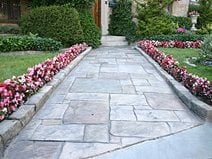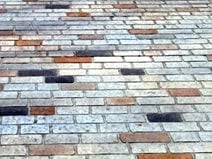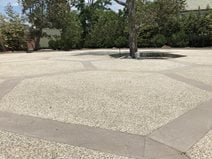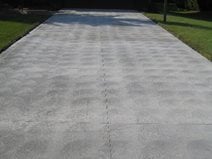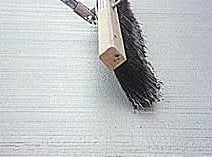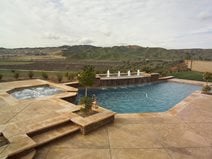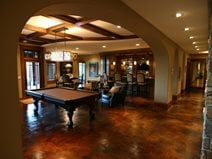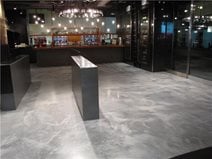- Stamped Concrete
- Stained Concrete
- Decorative Concrete Overlays
- Colored Concrete
- Concrete Polishing
- Concrete Countertops
- Concrete Resurfacing
- Design Ideas for Decorative Concrete
- Concrete Designs: Decorative concrete ideas for patios, floors, driveways, pool decks, countertops, and more
- Six Hot Decorative Concrete Design Ideas on a Budget
- What Is Decorative Concrete?
- Glossary of Decorative Concrete Terms: What is a band? What is a field?
- Types of Textured Finishes: Float and trowel textures, broom finishes, rock salt
- Decorative Concrete Mix Design
- Decorative Concrete Cost
- Maintaining Decorative Concrete
- Cleaning Decorative Concrete
- Concrete Sealers
- Other Resources
- Going Green with Concrete Floors and Countertops: An overview of concrete's eco-friendly benefits
- Concrete Contractors: Find A Concrete Product Supplier or Distributor
Textured Concrete - 10 Types of Concrete Finishes for Indoors & Out
Compare concrete finish options that range from simple to elaborate texturesTextured concrete finishes range from simple to elaborate and affordable to expensive. Some are easy to create, while others require special skills. Certain concrete textures serve functional purposes, while others are highly decorative. Read on to decide which option is best for you.
Concrete Finishes for Outdoor Applications
1. Stamped concrete
Stamped concrete, commonly referred to as textured or imprinted concrete, is a type of concrete finish designed to resemble brick, natural stone such as slate or flagstone, tile and even wood. Color hardener is a popular way of coloring concrete that accentuates the stamped pattern.
2. Stenciled concrete
Stenciling concrete can be a great alternative to decorative stamping while permitting similar design flexibility. Stencils are typically used in conjunction with staining concrete or resurfacing. Concrete engraving can also be used to create similar effects.
3. Exposed aggregate
An exposed aggregate surface is obtained by placing concrete and then removing the top layer of cement paste to uncover coarse decorative aggregate. The most popular decorative aggregates are richly colored natural stones such as basalts, granite, quartz, or limestone. But you can also use materials such as recycled colored glass or seashells and other interesting objects seeded into the surface of the concrete.
Ready to get started? Find decorative concrete contractors near me
4. Float and trowel finishes
Patterns can be made on the concrete, such as swirls, or different size arcs. The texture created can be coarse, medium, or smooth depending on the tool used to impart the pattern. Wood floats create coarser textures. Aluminum floats or steel trowels create medium or smooth finishes.
5. Broom finish
Broom finished concrete can be light or coarse depending on the bristles of the broom you choose. This is not a fancy finish but provides a non-slip surface which is important for safety around swimming pools.
6. Rock salt finish
Water softener salt crystals 1/8" to 3/8" in size are broadcast onto the fresh concrete. A roller is then used to press the salt crystals into the concrete. The surface is later washed, dissolving the salt and leaving small holes. Read more about rock salt finishes.
7. Colored finish
Concrete can be colored in a variety of ways, but integral color and color hardener are two popular options, especially outdoors. Integral color is added to the concrete mix before pouring, while color hardener is broadcast onto freshly placed concrete and finished into the surface. Both of these colored finishes can be used alone or combined with various texturing methods such as stamping, exposed aggregate, brooming and more.
Concrete Floor Finishes
8. Polished concrete
Polished concrete is the ultimate modern flooring material, where the surface of the concrete is ground to a high-gloss finish. Homeowners, retailers, big-box stores, educational and medical facilities are choosing polished concrete for their floor finish because of the competitive advantage it offers over other types of floor coverings.
9. Stained concrete
Staining is the most popular method for enhancing both commercial and residential concrete floors. Stained concrete is a good finish for both new or existing floors and works equally well with concrete overlays. Colors can mimic marble, leather, natural stone or even wood.
10. Epoxy coatings
Epoxy concrete floor coatings are a great option if you are looking for tough and attractive flooring. They are popular in auto shops, restaurants, salons, retail stores and more. Customize your coating with metallic pigments, decorative chips, or mosaic-like terrazzo.
What is the cheapest concrete finish?
Finishes that are done by the concrete finisher, or maybe one or two extra workers on the crew, are going to be the least expensive of the decorative concrete ideas listed here. The reason is because they require few added materials to produce (except for maybe several bags of salt or a broom). When special tools are required, like stamps or stencils, the price of your concrete project will rise.
The best outdoor finish options if you're on a budget are:
- Float and trowel finishes
- Broom finish
- Rock salt finish
For an indoor floor, staining would be the least expensive option.
What is the best concrete finish for new vs. old concrete?
Many people believe that stamping, exposed aggregate and even broom finishing require fresh concrete. But with concrete resurfacing you can often get the same finishes even on existing surfaces.
